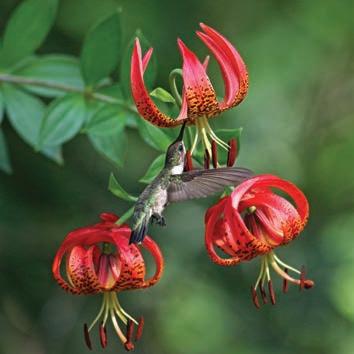
3 minute read
Birdwatch
Ruby Ready
L a dies an d gentl emen, st ar t your feed ers
Advertisement
By susan CaMPBell It’s that time, folks! North Carolina’s smallest bird, those winged jewels that have spent the winter in the tropics, are now headed back our way. Ruby-throated hummingbirds will be returning to gardens and feeders by mid-April. So, it’s time to get ready!
First and foremost, in spite of what you may have heard, these tiny dynamos are mainly insectivorous. Bugs of all kinds make up the majorit y of their diet. Anything small enough to fit down the hatch will be consumed throughout the day — followed up by a nectar chaser ever y now and then. Therefore, it is critical to be judicious year-round in your use of pesticides and herbicides, so that the invertebrates hummingbirds depend on will thrive.
Consider planting for your hummers. There is a wide array of plants that are easy to grow that will get the birds’ attention. The best are obviously native species such as trumpet creeper, coral honeysuck le, cardinal flower, bee balm, columbine and even butterfly weed. There are loads of non-native perennials that are a wonderf ul (and not invasive) addition to your hum-garden, like many of the salvias, Mexican sunflower, sultan’s turban and lantanas. Do not be surprised if you see a hummer hovering around the vegetable garden when your okra starts to bloom or your basil goes to seed. Keep in mind that the thicker the vegetation is in your yard, the buggier it will tend to be — a good excuse to let things go wild in at least a section of the propert y. And dense vegetation will also provide the birds with necessar y cover for roosting, as well as protection from the elements and potential predators.
Of course, many of us have augmented our yards with sugar water feeders that will bring the tiny birds into view. W hile there are many brands on the market — with more being added ever y season — they var y in qualit y and ef fectiveness. No matter what kind you choose, be sure it can be opened up for complete cleaning and that the ports are large enough (at least 3 mm) not to cause bill injur y. Hummer feeders need to be cleaned with hot water (no detergent) at least ever y three days during the heat of the summer, so easy access for ef fective scrubbing and rinsing is critical. A 10 percent bleach solution is fine later in the season when mildew can be an issue. Just be sure to rinse all of the parts ver y thoroughly before refilling.
The best choice for of fering homemade nectar is a saucer-st yle feeder, such as a HummZinger, that pops apart for easy cleaning and refilling. The beaut y of these feeders is that they do not tend to seep or drip and, as a consequence, are less likely to attract the bees and wasps that reser voir-st yle feeders do. A lso, many designs now have a built-in ant moat that creates an ef fective barrier to those even tinier sugar-loving critters that abound in our area during most of the year.
Please avoid store-bought mixes. They can contain additives and preser vatives that may not be good for the birds. A simple mix of 1 part sugar to 4 parts water is all you need to use. Adding color to the fluid is not recommended, nor is it necessar y. Red dye is usually a petroleumbased compound that the birds cannot digest. Besides, ruby-throateds have phenomenal color vision and can see the red components of your feeder from over a half a mile away.
L ast but not least, although hummingbirds do not use conventional bird baths, they do need to keep their feathers clean. There are specialt y fountains on the market that are ver y shallow and may attract them to bathe, though it’s more likely you will see a ruby-throated rinsing of f by making passes through your sprink lers. You could even have a close encounter with an overheated ruby-throated if you happen to be watering with a hose during the heat of the day. OH Su san w oul d l o ve t o receive y our w il dlife obser vat ion s an d /or ph ot os at su san@n c ave s.com.





